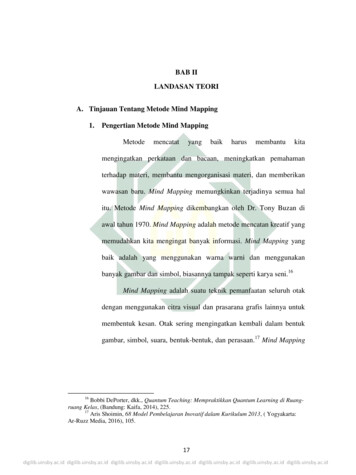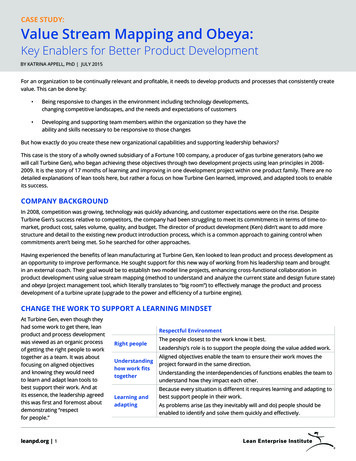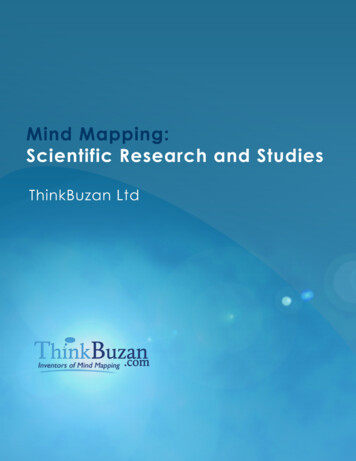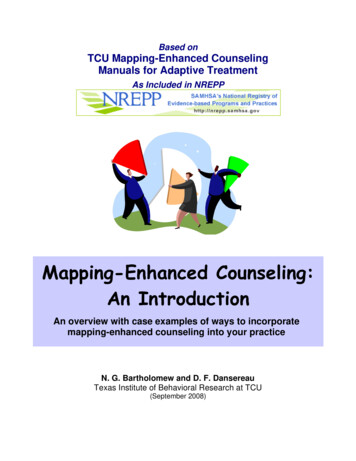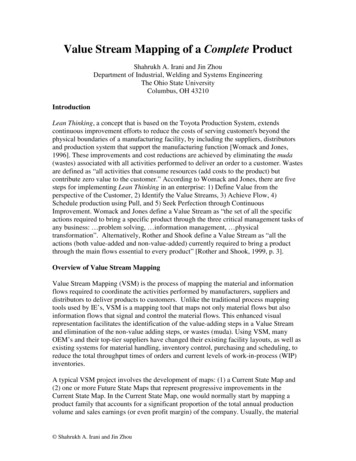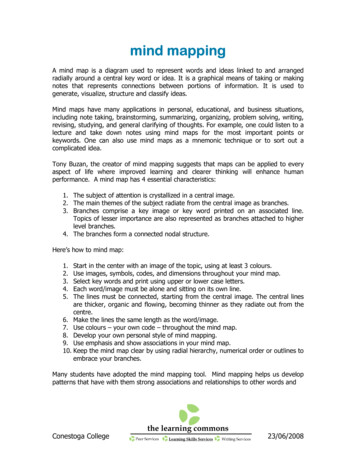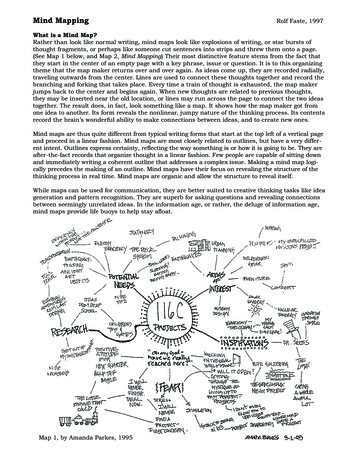
Transcription
Self Study Programs:Mind Mappingwww.jcu.edu.au/students/learning-centreThis module covers: Constructing mind maps Using mind maps to prepare for essays Using mind maps to prepare for notetaking
Mind MappingMind maps are tools which help you think andlearn. This workshop describes how to do a mindmap and in what contexts you might use them,such as when preparing for an essay, takingnotes or preparing for exams.creatively and in a non-linear manner. There willbe plenty of time for modifying the informationlater on but at this stage it is important to getevery possibility into the mind map. Sometimes itis one of those obscure possibilities that maybecome the key to your knowledge of a topic.3. Write down key ideasThe information in this module has been adaptedfrom the work of Tony Buzan and others whohave promoted mind mapping as a learning andthinking tool. For a full explanation of the mindSome students find that using capital lettersencourages them to get down only the keypoints. Capitals are also easier to read in adiagram. You may, however, wish to write downmapping technique see Buzan, T. (1991). TheMind Map Book. New York: Penguin.some explanatory notes in lower case. Somestudents do this when they revisit the mind mapat a later date while others write in such thingsas assessment criteria in this way.How to do a Mind MapMind mapping (or concept mapping) involveswriting down a central idea and thinking up newand related ideas which radiate out from thecentre. By focussing on key ideas written down inyour own words, and then looking for branchesout and connections between the ideas, you aremapping knowledge in a manner which will helpyou understand and remember new information.4. Put the main idea in the centreMost students find it useful to turn their page onthe side and do a mind map in "landscape" style.With the main idea or topic in the middle of thepage this gives the maximum space for otherideas to radiate out from the centre.5. Leave lots of space1. Look for relationshipsUse lines, colours, arrows, branches or someother way of showing connections between theideas generated on your mind map. Theserelationships may be important in youunderstanding new information or inconstructing a structured essay plan. Bypersonalising the map with your own symbolsand designs you will be constructing visual andmeaningful relationships between ideas whichwill assist in your recall and understanding.2. Draw quickly on unlined paper withoutpausing, judging or editingAll of these things promote non-linear thinkingand the idea of mind mapping is to thinkSome of the most useful mind maps are thosewhich are added to over a period of time. Afterthe initial drawing of the mind map you may wishto highlight things, add information or addquestions for the duration of a subject right upuntil exam time. For this reason it is a good ideato leave lots of space.Try Activity 1 Imagine you have the task of trying to explain tosomeone how to do a mind map. Your task in thisactivity is to construct a mind map about how todo a mind map! After you have finished yourmind map, you may like to search “how to do amind map image” online and see how othershave completed this task.1
Essay PreparationAreas to researchMind maps can help you in the early stages ofyour essay by summarising your research andproviding you with a picture of all aspects of thequestion. You can then move from your nonlinear mind map to a more structured essay plan.The areas to research will be suggested by thepossible topics and from here your mind mapmay lead you on to various sources ofinformation you will need to pursue. Often youwill have to choose carefully which areas will bethe most productive and relevant to research.Alternative approachesOne of the powerful things about mind mappingis that it is a tool which encourages creativethinking and often creative solutions toproblems. Always look at alternative ways ofapproaching essay questions and always beprepared to be a critical researcher and writerwho is prepared to go outside the normalHousekeepingIt is often useful to put down on the mind mapvarious "housekeeping" details such as: assessment criteria and weighting due date timeline any other requirementsPrior knowledgeboundaries!Sample Essay Mind MapThis mind map was used to plan a critical essay inengineering. It doesn't use capitals or includeitems such as assessment criteria but it doesshow a thorough outline of possible approachesthe student could take.You should always put down on your mind mapall that you already know about the essayquestion. This knowledge may have come frompersonal experience, lectures, readings or othersources. You may be surprised as to how thispart of the mind map branches out in lots ofdirections!Possible topics to be coveredMost essays will involve the possibility of tacklinga number of topics within the question. Put all ofthese possible topics down. You may not havethe time or length of essay to tackle all of thembut getting them down and looking forconnections, relevance and priorities is a goodstart.2
Summarising Readings5. PersonaliseUsing different colours or symbols, add your owncomments and questions to the mind map.Questions relating to relationships, implications,alternative approaches, usefulness, clarity andpersonal experience could all be considered atthis stage. It is in this personalising stage whereMind mapping can help you understand andremember the important issues in your readings.your mind map really starts to help you with yourlearning. The trick now is to address all thosequestions you have raised and to keep returningto your mind map with the answers!We suggest you follow 5 steps in creating mindmaps which summarise your readings.1. SkimFirstly, read the abstract, introduction,conclusion, key headings or chapter headings.When skimming through the text observe anydiagrams, pictures or graphs. This gives you anoverview of what you are about to read, puts it incontext and may already give you some clues asSample Reading Mind Mapto where the most relevant parts are located.This mind map contains only the essential pointsa student picked up from the first reading of atext and was produced from memory alone. Thestudent who produced this mind map then wenton to add details and questions and then consultthe text again. Notice how space has been leftfor this purpose.2. ReadRead the article in one sitting (or chunk it intosections/chapters if it is a whole book) and goover any parts of which you are not quite sure.3. Mind MapIt is important to do the mind map from memoryat this stage so don't consult the article or anyother source of information.4. StudyThe mind map you have just done (in steps 1-3) isvery valuable as it will show the areas you haveunderstood and also areas about which you areTry Activity 2 Some people use mind maps to manage theirtime. Construct a mind map of how you intend touse your time over the next seven days.unsure. Study your mind map to discover thegaps in your knowledge and refer back to thesource material to fill in any of these gaps.3
Lectures, Seminars, Workshops andTutorialsSome students find it useful to create mind mapsfor various sessions where new information ispresented. Mind mapping can be a helpful notetaking and summarising tool.Better recallBy having all of the information covered in asession incorporated into a single mind map,many students find this an aid to themremembering what was covered.Prompts questionsYou mind map should raise some questionsabout the information you have received.These questions will need to be followed upon so it is important to develop your ownset of symbols which will prompt furtheraction by you.Helps exam preparationAdds structureMind mapping can help you record informationin a structure that suits your learning style andmeans something to you. The content may becoming at you thick and fast but a mind mapallows you to put information where you want itand make the necessary connections.Helps reviewImagine how useful it would be if you had a setof mind maps for each of your lectures! Thesemind maps would show you the areas where youhad difficulty and include the follow-upinformation you added in order to resolve theseproblems. You would also be able to construct amind map of the entire subject prior to the examand this would help you identify the key themesand likely exam questions.Sample Lecture Mind MapThe open space of a mind map can allow you torevisit it in that first vital review after the session.It is in this first review that you can highlight keyareas, gaps in your understanding and listquestions that need to be addressed. Somestudents find it hard to consult a mind mapduring a lecture so they take standard notes inthe lecture but construct a mind map afterwardsin their first review of the lecture notes.Suits repeated reviewsBy continually returning to your mind maps ofthese sessions you can use the empty space toadd new information and to expand on yourunderstanding of the work covered in thesession.This mind map was produced from standardlecture notes so that a student could clarify thekey points of the lecture. The mind map wasproduced in the first review after the lecture andwas added to throughout the semester. It wasthen used for exam preparation.4
Where to from here?Searching the web for “mind map” produces many useful resources and samples of mind maps. Here aresome that students have found useful: The following website contains many excellent examples of mind maps and links to relatedresources:http://mappio.com/Credo Reference is a database that has a clever tool that will construct a concept map on any topic.This is useful for brainstorming and refining a topic or refining a search for resources. Click on theConcept Map tab then type in your topic in the search du.au/home.doInspiration also lets you create mind maps on your computer (30 day free trial):http://www.inspiration.com/FreetrialThe following mind map was downloaded from www.learningfundamentals.com.au5
Tony Buzan . and others who have promoted mind mapping as a learning and thinking tool. For a full explanation of the mind mapping technique see Buzan, T. (1991). The Mind Map Book. New York: Penguin. How to do a Mind Map . Mind mappin
